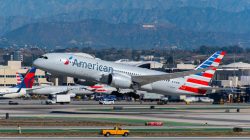Another year, another round of theatrics
American Airlines and Hawaiian Airlines have successfully convinced the US Department of Transportation to review, and potentially re-allocate, Delta’s authority to a single landing slot at Tokyo Haneda airport, which it currently uses to operate a nonstop flight from its Seattle hub.
This represents the latest chapter in a 5 year plus saga for US carriers to secure coveted access to four landing slots available to operate into Tokyo’s busiest airport, despite ever-increasing data points that receiving admittance to fly into the airport brings questionable incremental value to their networks.
The underlying logic for the DOT to consider re-allocation, as purported by the two plaintiffs, is that Delta is severely under-utililzing its nighttime slot at Haneda, which in turn results in a massive spoilage of already scarce resources that could be put to better use by another carrier. Their claims are valid given that Delta has greatly reduced its Seattle – Tokyo Haneda schedule between the months of October 2014 and April 2015, typically a slower travel period during the winter months, from a daily service to an irregular frequency. Per the conditions set by the U.S. DOT, a slot pair authorized to an airline becomes dormant if more than a 90-day period passes without the carrier operating a flight.
To circumvent this clause, Delta has chosen to operate a single week of service every 90 days to prevent its landing rights from expiring. The carrier flew 7 flights into Haneda in November 2014, and has 7 flights loaded into its inventory in February 2015, and 3 in March 2015. In total, according to CAPA, Delta is flying from Seattle to Tokyo a total of 17 days out of a possible 182, effectively “squandering” the rights to operate the route, as petitoned by American and Hawaiian, and thereby justifying the case for re-assigning the landing rights to another carrier who would, in theory, use the slot to its complete capacity.
Demand has consistently outstripped supply of Haneda slots since 2010
Government-owned Haneda airport, which is located much closer to Tokyo’s central business district, opened to US and foreign carriers in 2010 upon completion of a 4th runway construction project. This was a major milestone as Haneda airport is one of the busiest airports in the world, in fact larger than neighboring and privately-owned Narita airport, which, for 30 years prior to 2010, handled all intercontinental traffic to and from Greater Tokyo. However, Haneda’s proximity to Central Tokyo’s business district renders it a far more attractive airport for Tokyo’s origin and destination (O&D) passengers, whereas Narita is located over 35 miles east of the city and commands a much longer commute time.
The year Haneda became open to US carriers, five carriers – United, Delta, American, Hawaiian and Continental – submitted applications to the US Department of Transportation for four nighttime slot pairs into Haneda. Several of the carriers submitted multitple bids from multiple hubs: Continental desired service from its Newark and Guam hubs, while American wanted service from New York JFK and Los Angeles. Delta submitted four applications to serve Haneda from Seattle, Los Angeles, Detroit and Honolulu, while Hawaiian desired two daily frequencies from Honolulu. Only United bid for a single slot from its San Francisco hub.
Ultimately, the DOT granted two of Delta’s four applications – to Detroit and Los Angeles, as well as one of American’s – to New York JFK, and one of Hawaiian’s frequencies to Honolulu. The number of frequencies has not increased since then, but some re-shuffling has taken place. Delta was granted permission to move its Detroit – Haneda slot to Seattle and American surrendered its slot to United last year.
US carrier capacity performance at Haneda has been erratic, at best, since the start
At present, five carriers operate between Tokyo Haneda and various points in the United States, including two Japanese airlines (All Nippon Airways and Japan Airlines) and three American carriers (Delta, United and Hawaiian). Honolulu airport receives the largest number of seats from Haneda, with daily services each on ANA, JAL and Hawaiian. San Francisco is second largest with daily services on JAL and United, followed next by Los Angeles with daily services on ANA and Delta, and finally Seattle with Delta.
Data supplied by CAPA and OAG shows a stark contrast between American and Japanese carriers in terms of capacity allocation to Haneda airport from U.S. points since Haneda was opened to transoceanic services in 2010. Whereas JAL and ANA have maintained a fairly consistent offering of seats and frequencies throughout the years, Delta has shifted around capacity virtually every year since winning route authorities to Haneda, typically cutting seats by half during the winter periods. American briefly operated a daily flight from New York JFK to Tokyo Haneda from June 2012 through November 2013, but forfeited its slot after failing to achieve profits on the route, and the DOT later re-allocated the slots to United, which launched a daily flight to Haneda from its San Francisco hub a year later in November 2014.
US-based carriers, with Hawaiian being a possible exception, have struggled to achieve success at Haneda airport as they have only received nightime landing slots, which are unfavorable as they do not appeal to business travelers. A late-evening landing time into Haneda airport provides limited onward connection options to other markets in Asia, and therefore requires an overnight connection or renders an itinerary connecting through Haneda moot over Narita airport. Although Haneda’s appeal is its closer proximity to central Tokyo over Narita, the late evening arrival primarily benefits passengers originating or terminating their journey in Tokyo.
However, even for a large and lucrative origin and destination (O&D) market such as Tokyo, US carriers were forced to remain overnight (RON) at Haneda and depart in the early morning back to the U.S., which is costly from an aircraft utilization standpoint. Moreover, an early morning departure slot purportedly prevented outbound passengers from using public transportation to arrive at the airport in time for the return flight to JFK.
Delta has gradually managed to achieve more favorable slot times for its flights from Los Angeles and Seattle to Tokyo Haneda, with an early evening arrival from the U.S. and a late evening return departure back to both West Coast markets. However, not only does Delta also operate daily from both of these hubs to Tokyo Narita airport, Narita provides onward connections to several Asian markets (Singapore, Bangkok, Manila, Taipei and Shanghai) which likely cannibalizes traffic away from its Haneda flights. Truthfully, Los Angeles is a much larger O&D market to Japan over Seattle, hence why daily service can be sustained year-round. Seattle, on the other hand, likely sees a much larger drop in seasonal demand during the winter months and therefore cannot support healthy load factors and yields to Haneda in the off-season.
American and Hawaiian want to fly to Haneda from Los Angeles and Kona, respectively
Another interesting element to the saga is how American has done a complete 180 in 12 months in prioritizing its interest in Haneda now that it has cleared other big ticket items off its plate. When American announced it was relinquishing its New York JFK – Tokyo Haneda slot in fall 2013, the carrier opted to withdraw entirely from Haneda rather than suggest that its right be re-allocated to one of its other “cornerstone” hubs such as Dallas/Ft. Worth, Los Angeles or Chicago O’Hare. In theory, American may have had a justifiable business case at that point to retain a presence at Haneda and stymie a competitor, namely United, from gaining access to the airport, but there was bigger fish to fry, specifically attending to its legal battles with the US Department of Justice over the US Airways merger.
Now, one year later, American has emerged as a much leaner, more powerful competitor under a different leadership, with the mentality that its expansion plans in Asia are part of a broader, “long-term investment” to compensate for years of inertia in the 2000’s. Under this logic, American was the one who kicked the bees nest in October 2014 by petitioning the DOT to revoke Delta’s rights to Seattle – Haneda after the seasonal reductions became public, and offered to take the right and use it to commence daily service from Los Angeles to Tokyo Haneda in lieu of Delta from Seattle.
The petition was quick to ignite Hawaiian as well, who had bid against United in 2013 to launch a nonstop flight from Kona to Haneda, but lost as the DOT tends to favor carriers that can provide, “the largest public benefit” which obviously places San Francisco miles ahead of Kona.
Delta was quick to fire back, arguing against potential “bad policy” to recall its rights
By definition, Delta is not violating any terms that can legally strip them of their rights to fly into Haneda airport. The carrier maintained that the DOT had no former precendent of stripping an airline from its rights due to a “temporary reduction over a single traffic season.” However, Delta already has a checkered history of serving Haneda airport, and has received partial treatment from the DOT in the past. When Haneda slots became available to US carriers in 2011, Delta received two authorities to operate from Los Angeles and Detroit that year, while American and Hawaiian each received 1 apiece. Following the March 2011 Japanese Tsunami, American and Delta temporarily halted services to Haneda in wake of the aftermath as the market needed time to recover.
Shortly after resumption months later, Delta quickly down-gauged capacity on the DTW-HND and LAX-HND routes from 747s and 777s to Airbus A330s, citing sub-par performances from the ill-conceived times. Eventually, the situation became so dismal that Delta relinquished its Detroit – Haneda slot and re-applied with the US DOT to move the allocation to launch from its Seattle hub, which, to the surprise of many, was actually permitted by the DOT.
That being said, the favoritism doesn’t exempt Delta from cutting capacity to Tokyo when ideally, they could be better utilized by another carrier. The likely scenario is that Delta’s spool-up in creating an Asian hub in Seattle is still maturing and having a daily flight to both Narita and Haneda airports is overkill.
American will not be adding capacity to Japan if it wins the Haneda slot from Delta
As-is, American is already fighting an uphill battle in its application to siphon the route away from Delta given that it has already been given the opportunity to operate into Haneda airport – and failed. Moreover, one condition that works unfavorably against American is that the carrier has stated that if it wins the bid for Delta’s Seattle – Haneda slot, it will simply move its daily Los Angeles – Tokyo Narita flight to Haneda, resulting in zero net capacity gain to Tokyo. American used the same approach back in 2012 when it moved its New York JFK – Tokyo Narita flight to Haneda.
After winning last years’ bid to a Haneda slot, United also moved one of its two daily San Francisco – Tokyo flights from Narita airport to Haneda, rather than create additional capacity to Japan. Put simply, the only carrier who will reliably be creating new capacity to Japan will be Hawaiian, as the Kona to Tokyo market is currently unserved.
Hawaiian should win the Haneda slot if the DOT rules Delta’s use inconventional
Between the two competing bids, American from LAX to Haneda or Hawaiian from Kona to Haneda, Hawaiian presents the stronger case for utilizing Delta’s Seattle to Haneda slot, if the DOT determines that its rights should be re-allocated.
Hawaiian has provided the most stable number of seats to Tokyo Haneda since it won route authorities to commence services to the airport in 2010. The only other Haneda – U.S. route that has survived to date is Delta’s route to Los Angeles. In fairness, revoking one of Delta’s two daily flights into Haneda airport would still allow the carrier to maintain a presence at Haneda.
Further, American’s application to fly from LAX to Haneda is likely a political move aimed at stripping Delta from having access to a coveted market, rather than unlock a hidden fortune for American and OneWorld. It would be far more prudent for American to wait until the Japanese government, which owns Haneda airport, opens up two day time landing slots for US carriers, thereby allowing American, or any other potential bidder, to arrive into and depart from Haneda airport at earlier hours for maximized connection opportunities.
In the interim, it would be far more advantageous, in the long run, for American to actually wait until daytime slots become available to U.S. carriers, which is still in the negotiations process between Japan and the U.S. Rather than wage a battle for marginal slot times that Delta cannot sustain from Seattle year-round, American would be better off if the DOT ruled in favor of Hawaiian from a re-allocation standpoint. To be fair, Hawaiian stands the least to lose from nighttime arrival slots as a Kona – Tokyo Haneda flight will solely target O&D from Hawaii to Japan and follows a different scheduling and utilization pattern given Hawaii’s proximity to Japan relative to the mainland U.S.
Moreover, even if American lost in the short-run, it would appear stronger in the long-run during DOT proceedings for a potential day time slot. It would almost gurantee victory as the only transpacific US carrier without a presence at Haneda airport, and it would receive the most optimal slot times to achieve a stronger improvement record at Haneda.





